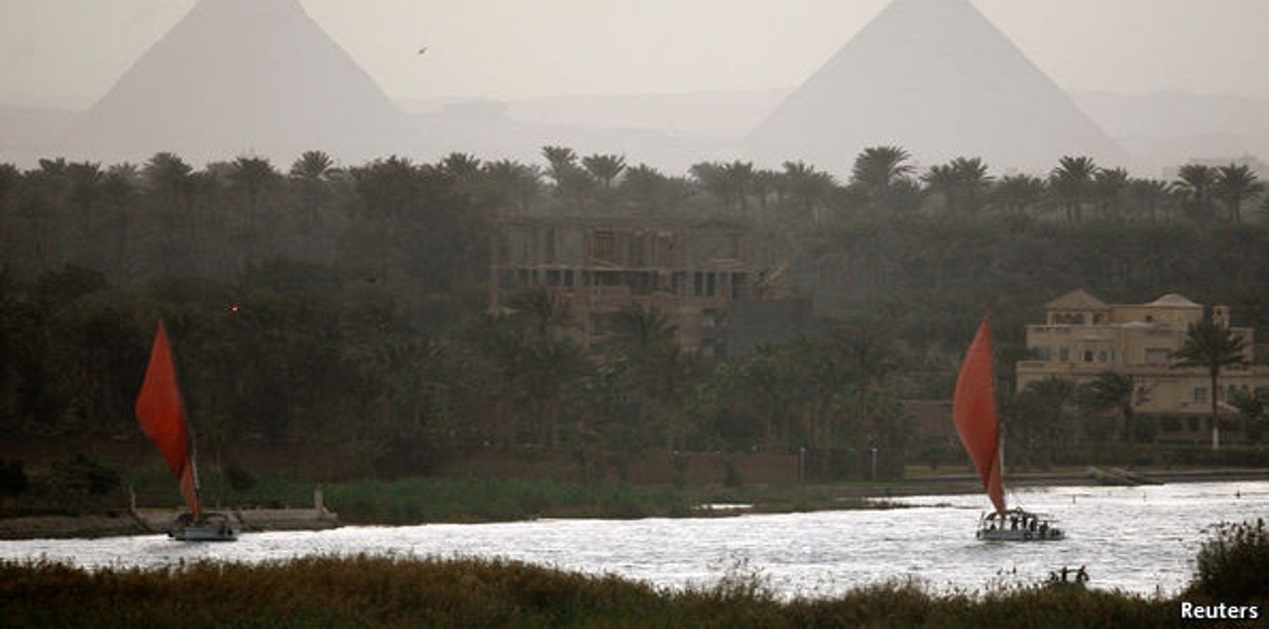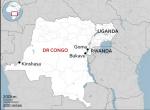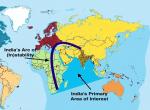The construction of the Grand Ethiopian Renaissance Dam (GERD) since April 2011 has emerged as a bone of contention between Egypt famously known as the ‘Gift of Nile’ and Ethiopia that controls 85 percent of the water flow of the river. The dispute has raised pertinent questions on development and environmental degradation; redefinition of colonial era agreements and post colonial nation-building in Africa; water and food security and the relevance of non-traditional threats in security policy making. The article would analyse the policies of Egypt and Ethiopia towards the Nile Basin and identify the problem areas that have impeded the successful resolution of conflict.
Ethiopia’s Plans and Egypt’s Opposition
The Nile River Basin covering a land area of 3.2 million sq kms passes through 11 states namely Egypt, Sudan, South Sudan, Eritrea, Ethiopia, Kenya, Uganda, Rwanda, Burundi, Democratic Republic of Congo (DRC) and Tanzania. The river basin is divided into 10 different sub-basins and two main branches i.e. White Nile and Blue Nile. The Blue Nile originating from Lake Tana in the north-western Ethiopian highlands contributes to 85 percent of the total water flow after it converges with the White Nile in Khartoum.12
Ethiopia that controls a substantial section of the Blue Nile intends to harness the water flow to generate electricity in the power-starved state. In May 2019, the Ethiopian Minister for Water and Electricity Seleshi Bekele introduced power-rationing schedule that furthered worsened the supply of electricity in households and industries.3 The current power capacity of the state is at 4300 Megawatts (MW).4 Therefore, the construction of the Grand Ethiopian Renaissance Dam (GERD) with an estimated cost of US$ 5 billion is envisioned as the largest hydro-electricity construction project in Africa that would be capable of generating power with an installed capacity of 6450 MW not only for domestic consumption but also for exports.5 Ethiopia exports around 100 MW each to Djibouti and Sudan and in 2018, the state earned around US$ 80 million in revenue. The power crisis in 2019 has forced the government to reduce the outflow of electricity to the neighbouring states. 6
For Ethiopia, the dam project would open new prospects for revenue with an estimated income of US$ 526 million per year. It is therefore seen as key to Ethiopia’s economic revival and establishing itself as a major light industry hub and a middle income state by 2025.7
Egypt however has opposed the project citing its historic rights over the control and share of Nile waters based on agreement it signed with Britain representing the colonial interests of Sudan, Uganda, Kenya and Tanzania in 1929. According to agreement signed on 7 May 1929, Egypt was allocated 48 Billion Cubic Metres (BCM) of water per year and Sudan was allocated 4 BCM of water per year. Egypt was also granted the right to monitor and veto construction projects in the upstream states. The agreement therefore granted Egypt exclusive control over the waters by dominating the share and the flow of the river. The advantage was offered based on the stipulation of Egypt’s complete dependence on the river as compared to the upstream states that have other water sources. Egypt was seen as a crucial agricultural asset by Britain that benefitted from the production of Egyptian cotton.89
Egypt’s control over the waters was further reinforced after Sudan, devoid of colonial overrule signed an agreement on 8 November 1959. Under the said agreement, the water allocation for Egypt and Sudan was increased to 55.5 BCM and 18.5 BCM respectively and the water from the increased yield was equally divided. 10 The 1959 agreement, failed to acknowledge the water needs of other Nile Basin states including Ethiopia.
Egypt has maintained that the 1929 and the 1959 agreements are legally binding and resisted any alteration to the status quo. Ethiopia and other African states gaining independence from colonial rule were however unwilling to acknowledge the colonial era agreements that unfairly offer advantage to Egypt over the share of water. These states have challenged the past agreements calling it non-binding due to their non-representation as colonial subjects. The past agreements failed to accommodate their concerns and resistance against the need for Egypt’s approval to pursue its national development goals increased in succeeding years. 1112
Eventually on 22 February 1999, the Nile River riparian states excluding Eritrea signed the Nile Basin Initiative (NBI) to promote consultation and coordination for sustainable management over the use of the waters and develop institutional and legal framework to govern the river basin. 13
The 1999 understanding was however compromised in 2010 after Egypt and Sudan rejected the Comprehensive Framework Agreement (CFA) drafted and signed by Ethiopia, Burundi, Kenya, Rwanda, Tanzania, and Uganda. Egypt sought amendment in the CFA by inserting that the agreement would not affect the ‘current uses and rights’ of any Nile Basin states suggesting its acquired ‘historic’ rights. Other upstream states rejected Egypt’s proposal which they argued would continue to provide unfair advantage to Egypt and preserve inequality. Egypt also refused to comply with the clause to implement equitable distribution and insisted on maintaining the status quo in the framework agreement. 14
In 2010, the Ethiopian government under Meles Zenes announced its plan to develop hydroelectricity project in the Blue Nile.15 Egypt under then President Hosni Mubarak registered its protest in regional and international forums and requested international donors to reject funding request.16 Egypt has maintained that control over the river is crucial for its survival and political regimes have threatened to use force to maintain its dominance. Notably, after signing the 1979 Camp David Accord, the then President Anwar Sadat opined that water is the only issue that may drag Egypt towards a potential conflict. 17
In the post Arab Spring period, Egypt’s first democratically elected President, Mohammad Morsi also suggested that while it is not calling for war, it is ready to confront any state that threatens its historic rights to the river. He famously announced that "If it loses one drop, our blood is the alternative," to his supporters.18 Egypt’s current President Abdel Fatah Al Sisi has claimed the river as “a question of life, a matter of existence for Egypt” in the UN General Assembly in September 2019.19 The Arab state’s symbolic attachment with the river has been repeatedly emphasised by the successive regimes.
For Ethiopia that controls major chunk of the river, the Egyptian approval for construction has emerged as an instance of infringement to national sovereignty. The construction of the dam has been treated with nationalistic fervour within Ethiopia, to gather momentum domestically, to resist any external challenge and accomplish its objective.
Environmental Impact on Egypt
According to the project plan, the main dam covering an area of 1780 sq kms would store around 15 BCM of water and the auxiliary dam that would divert excess water towards the river is capable of storing 60 BCM of water. Therefore, the combined capacity of the dam is 75 BCM.20 Egypt is concerned about the ramifications of project in terms of supply of water in the Nile River. Egypt is wholly dependent on the river with 91.5 percent of its total population residing in the Nile Basin.21
The 161 kms long Nile Delta between Alexandria in the west and Port Said in the east contributes half of the state’s agricultural production and hosts 40 million people. It is therefore, unwilling to compromise on its designated share at 55.5 BCM agreed in the 1959 treaty with Sudan.
Egypt’s annual water reserves and agricultural area, after the completion of the GERD project, would be dependent on the duration of time taken by Ethiopia to fill the reservoir. Therefore, in case of shorter timeframe in filling the reservoir, the water flow in Egypt would significantly reduce. Egyptian Space Scientist, Dr Essam Heggy in collaboration with Al Jazeera has projected the water loss and loss of agricultural area in Egypt during 21, 10, 7, 5 and 3 years timeframe by Ethiopia.

Table 1 indicates that in case of shorter duration of 3 to 5 years in filling the reservoir, Egypt may lose 50 to 67 percent of its agricultural area. Moreover, the allocated share of 55.5 BCM will also be significantly compromised in case of shorter timeframe.
The construction of the dam began in April 2011. During this period, the domestic political situation in Egypt was highly fragile and inward looking as a consequence of the Arab Spring protests. The Egyptian government due to its failure to halt the construction process, sought to internationalise the dispute to impose pressure on Ethiopia. Ethiopia refused to consider Egypt’s proposal to conduct impact studies before pursuing the construction. It also rejected Egypt’s demand to revise the design of the dam and incorporate four extra spillways to maintain regular water flow in case of malfunction in primary floodgates.22
For Ethiopia, the potential for conflict has largely discouraged international donors to contribute in the US$ 5 billion mega project. The Ethiopian government has therefore largely relied on taxes, donations and government bonds. The government sold US$ 56 million in bonds to the Ethiopian diaspora in 2018. 23
Private firms from Ethiopia and neighbouring African states have been encouraged to purchase bonds. The government employees have also donated one month worth of salary for the project. The state owned Ethiopian Electric Power Corporation (EEPC) also invested its revenue and loaned money from banks for construction. The reliance on self-financing model rather than dependence on external donors have been largely appreciated. There were however reports of corruption and lack of transparency that has dented the image of the ambitious plan domestically within Ethiopia.24
Sudanese Perspective on the Nile Dispute
In the case of Sudan, it is stuck in the diplomatic crossfire between Egypt and Ethiopia. Sudan is a political and military ally of the Saudi led anti-Iran bloc that also includes Egypt. It sided with Egypt to oppose the 2010 agreement to equitably share the waters.25 On a comparative scale, the dependence on the waters of the river is much lesser in Sudan than Egypt. The waters from the Nile contribute to 20 percent in the agricultural sector in Sudan.26 Sudan in compliance with the provisions of the 1959 agreement had built Roseires Dam in 1966 and Merowe Dam in 2009 capable of generating 1250 MW of electricity. Sudan reservoir capacity at 12.5 BCM is below the allocated 18.5 BCM quota available under the 1959 deal.27
From the Sudanese perspective, the construction of the GERD would be beneficial for regulating the flow of the water to reduce the occurrence of floods and increase agricultural output. Moreover, it could gain access to affordable energy from Ethiopia. Sudan is likely to benefit from the dam; however it may also face severe challenges in case of impasse in solving the dispute. It is therefore in favour of reconciliation and initiated series of engagement between both sides. After Morsi’s ouster in Egypt in July 2013, the Abdel Fatah Al Sisi government met with the Ethiopian delegation in Khartoum on 4 November 2013.28
Diplomacy and Conflict
On 23 March 2015, as a result of Sudan’s diplomatic efforts, the Egyptian President Abdel Fatah Al Sisi, Ethiopian Prime Minister Hailemariam Desalegn and Sudanese President Omar al-Bashir signed an agreement in Khartoum to safeguard Egypt’s share of the waters while continuing the construction of the mega project.29
The agreement reflected shift in Egypt’s approach towards accepting the non-sustenance of the past agreements and accommodating Ethiopia’s power needs and economic aspirations. Moreover, it appeared that Egypt is aware of risks of a conflictual approach that may close the diplomatic options and weaken its position in determining the share of the Nile waters. However, both states continued to disagree about the duration of time for filling the reservoir along with differences over the environmental impact and the severity of droughts.30
Egypt continued to insist on a longer timeframe of 10 to 21 years for Ethiopia to fill the reservoir and only during the rainy season. Egypt also wants Ethiopia to increase the number of water release points in the dam to maintain adequate water flow.31 Ethiopia however objected to Egypt’s demand that would slow down its hydroelectricity production plans and expressed intention to fill the reservoir in shorter duration of 3 to 6 years. The dialogue process continued after 2015, but it failed to resolve the core issues between both states.32
Egypt as a result of the diplomatic impasse, threatened Ethiopia with military action including air strikes to halt the development project. Ethiopia in 2017 accused Egypt of supporting Ethiopian rebels, Oromo Liberation Front (OLF) operating from Eritrea to sabotage the dam site. Moreover, the killing of the Chief Engineer of the hydroelectricity project, Simegnew Bekele on 26 July 2018 raised suspicions about Egypt’s complicity.33 The killing led to protests within Ethiopia, the tensions however subsided after the government claimed the death as an act of suicide.
The crisis, at the same time, continued due to contradictory approaches by both states. In 2018, the US intervened in the dispute as an observer. The US alongwith World Bank urged Ethiopia to fill the reservoir in stages and in cooperative manner during the rainy season between July and August 2020. According to the US led proposal, the initial accumulation of water at 595 metres above sea level would be sufficient for power generation. It also suggested Ethiopia to consider the hydrological conditions of the Blue Nile and undertake mitigation measures to prohibit the occurrence of droughts in Egypt and Sudan.34
Ethiopia reluctantly participated in the US led discussion. It broadly agreed with the preliminary agreement over stages for filling the reservoir. It however backed out from the succeeding US led negotiations citing favouritism towards Egypt during the negotiations. Ethiopia claimed that the said proposal hinders use of the Nile waters within its territory. Ethiopia maintained its hesitation over internationalising the dispute and rejected arbitration by the World Bank earlier in January 2018. 35
Besides the US, the Arab League has broadly supported Egypt’s position over its historic rights over the waters. During 153rd session of the Arab League Council in March 2020, it linked Egypt’s water security with Arab national security. The council rejected Ethiopia’s unilateral action to fill the reservoir and operating the dam without reaching a balanced final agreement. It urged Ethiopia to acknowledge Egypt’s needs and sign the initial agreement.36 Ethiopia maintained that it would proceed ahead with its plans to fill 4.9 BCM of water from July 2020 to generate electricity.37
Besides Egypt, Sudan has also asserted the risks in filling the reservoir without reaching a final agreement. Sudan fears that Ethiopia’s unilateral actions may endanger the operation and safety of the Roseires Dam. It is therefore in favour of developing proper communication channels determined through legally binding agreement to ensure that water release from the GERD is coordinated with the water level in Sudan’s dams.38
Ethiopia due to lack of support from the Arab states has opted for a more Africa centric approach that would appreciate the rights of a fellow African state to govern its own resources. In its efforts, it requested South African President Cyril Ramaphosa, the current chair of the African Union (AU) to mediate in order to resolve the dispute.39 The African Union favours a mediated solution towards the dispute. It acknowledges Egypt’s concerns for water and food security. At the same time, it is sympathetic towards the demands of the upper riparian states for a more equitable distribution of the water resources.
Eventually, the heads of state of Egypt, Ethiopia and the Sudan held an extraordinary virtual meeting chaired by South African President Cyril Ramaphosa on 26 July 2020. The participants agreed that the dispute is an African issue that requires regional solutions. Ethiopia therefore sought to overcome the interference from the United Nations (UN) as well as the US. All states agreed to delay the filling of the dam until the conclusion of the final agreement within two or three weeks. A committee of technical and legal experts has been constituted to frame the terms of the final agreement. The committee would also include representatives from Kenya, Mali and DRC and international observers, including the US, EU and South Africa.40 The technical aspects of differences over the timeframe; dispute resolution mechanism; legally binding nature of the agreement; maintenance of minimum flows in lower riparian states however have not been clarified.
The current understanding due to lack of consensus is likely to lead to an inconclusive agreement in which either side may violate the provisions. Ethiopia has regularly used the upper hand it enjoys in controlling the major chunk of the water flow to withdraw from discussions expressing bias in favour of Egypt and has gone ahead with unilateral measures. Even in case of the best case scenario, Egypt would continue to face risk of water shortage and efforts must be made to meet its requirement of water and food security. Egypt in order to overcome the impending water crisis has to bear substantial costs especially so in its agricultural production. Aswan Dam with the capacity to store 162 BCM of water could be used to redirect the water flow to replenish the loss arising from the Ethiopian project in seven years duration. It would also have to take recourse to exploiting the 2 BCM of non-renewable ground water which is environmentally unsustainable. Moreover, in the agricultural sector, it would be forced to promote low water intensive crops. Sustainable measures such as improvement in irrigation methods, recycling and desalination could also reduce the pressure of water loss. However, these measures are highly expensive and it would take long time to compensate for such losses.41
In terms of Ethiopia’s hydroelectricity project, experts have suggested that the water flow in the Nile would be prone to climate variability in the near future. It may adversely affect the power generating capacity of the GERD in which it will operate in its peak capacity only during the rainy season for few months. It would therefore be unable to meet the power demands within the state reducing its efficiency.42
China’s interests
China is reluctant to directly intervene in Egypt-Ethiopia dispute. It has infused loans, investments, and development projects worth US$ 20 billion in Egypt. Egypt is a key element in China’s Belt and Road Initiative and it has committed to undertake projects such as the redevelopment of the Suez Economic Zone and building solar power plans and light rail transit system.43
China at the same time has offered loans to develop power lines and infrastructure in Ethiopia to compliment the hydroelectricity project. In April 2013, it offered US$ 1.2 billion in loans to build transmission line between the dam and Adis Ababa.44 In February 2019, the Ethiopian Electric Power Corporation (EEPC) signed US$ 40 million contract with China Gezhouba Group Co., Ltd to handle the pre-commissioning activities. The EEPC also signed US $113 million contract with Voith Hydro Shanghai to supply electrical, mechanical and civil and structural works required for finishing the generating station and spillways.45 In April 2019, the State Grid Corporation of China announced that it would invest US $1.8 billion to build electricity transmission and distribution networks.46 China is seeking to maintain the growing political and economic ties with both Egypt and Ethiopia. It therefore in favour of successful resolution of the dispute and timely completion of the dam project.
Conclusion
Egypt has traditionally maintained a rigid position over the control of the waters citing its historic rights deriving from the 1929 and 1959 agreements. Concurrently, the post colonial nation building process in the Nile Basin states facilitated efforts to gain control over natural resources including water. The 1929 and 1959 agreements failed to appreciate the interests of the colonised subjects. The post colonial states and Ethiopia therefore sought to rearrange the sharing norm that offers strategic advantages to Egypt.
Egypt, after the GERD dam was announced, challenged Ethiopia’s efforts by internationalising the dispute, raising environmental concerns and issuing military threats. It concentrated its efforts to halt construction to avoid catastrophic effects on Egypt’s water security and food security. However, after construction continued unabated, the frequency of threats including air strikes increased raising the potential of a water war. However, international and regional actors disfavour escalation and largely empathise with Egypt’s position including the Arab League and the US which has affected Ethiopia’s funding channels.
Ethiopia has refused to comply with Egypt’s demands and the project is glorified as a symbol of its sovereign right and national pride. After years of negotiations, the two warring sides and Sudan have finally agreed in June 2020 on a preliminary arrangement to conclude a legally binding final agreement before filling the reservoir. The success of the agreement would lie in Ethiopia accommodating Egypt and Sudan’s genuine concerns while pursuing its goals. Moreover, robust dispute resolution mechanism and application of punitive measures to check unilateral action must be engrained in the new deal which would be difficult to pursue due to mutual distrust and contradictory concerns of Egypt, Ethiopia and Sudan that may disrupt the positive environment in near future.
References:
- International Rivers, ”Nile Basin,” International Rivers, 2020, at https://www.internationalrivers.org/campaigns/nile-basin (Accessed June 29, 2020).
- Waternet, “The Nile River Basin - an introduction,” Waternet: On the geopolitics of water scarcity, 2020, at https://www.waternet.be/nile (Accessed June 28, 2020).
- Al Jazeera, “Ethiopia begins rationing electricity for homes and industries,” Al Jazeera, May 18, 2019, at https://www.aljazeera.com/news/2019/05/ethiopia-begins-rationing-electricity-homes-industries-190518064742084.html (Accessed June 27, 2020).
- Xinhuanet, “Ethiopia encounters energy deficit amid water shortages in major plants,” May 18, 2019, at http://www.xinhuanet.com/english/2019-05/18/c_138067524.htm (Accessed June 29, 2020).
- Hydropower, “Ethiopia - Grand Ethiopian Renaissance Dam (GERD),” Hydropower, 2020, at https://www.hydropower.org/case-studies/ethiopia-grand-ethiopian-renaissance-dam-gerd (Accessed June 28, 2020).
- International Trade Administration, “Ethiopia: Energy,” International Trade Administration, October 13, 2019, at https://www.trade.gov/knowledge-product/ethiopia-energy (Accessed June 27, 2020).
- E. Kebede, “The Financing of the Grand Ethiopian Renaissance Dam (GERD),” Nazret, 2020, at http://nazret.com/blog/index.php/2015/03/30/ethiopia-the-financing-of-the (Accessed June 26, 2020).
- M. S. Klmenyl and J. M. Mbaku, “The limits of the new “Nile Agreement”, Brookings, April 28, 2015, at https://www.brookings.edu/blog/africa-in-focus/2015/04/28/the-limits-of-the-new-nile-agreement/ (Accessed June 28, 2020).
- Middle East Eye, “Explained: The Grand Ethiopian Renaissance Dam,” Middle East Eye, July 10, 2020, at https://www.middleeasteye.net/news/grand-ethiopia-renaissance-dam-explained-egypt-sudan (Accessed July 11, 2020).
- FAO, “Agreement between the Republic of the Sudan and the United Arab Republic for the full utilization of the Nile waters signed at Cairo, 8 November 1959,” Food and Agriculture Organisation, 2020, at http://www.fao.org/3/w7414b/w7414b13.htm (Accessed June 29, 2020).
- The Conversation, “Agreements that favour Egypt’s rights to Nile waters are an anachronism,” The Conversation, November 4, 2018, at https://theconversation.com/agreements-that-favour-egypts-rights-to-nile-waters-are-an-anachronism-103353 (Accessed June 27, 2020).
- The Conversation, “Colonial-era treaties are to blame for the unresolved dispute over Ethiopia’s dam,” The Conversation, March 26, 2020, at https://theconversation.com/colonial-era-treaties-are-to-blame-for-the-unresolved-dispute-over-ethiopias-dam-133538 (Accessed June 28, 2020).
- Nile Basin Initiative, “Who We Are,” Nile Basin Initiative, 2020, at https://www.nilebasin.org/nbi/who-we-are (Accessed June 29, 2020).
- M. S. Klmenyl and J. M. Mbaku, “The limits of the new “Nile Agreement”, Brookings, April 28, 2015, at https://www.brookings.edu/blog/africa-in-focus/2015/04/28/the-limits-of-the-new-nile-agreement/ (Accessed June 28, 2020).
- K. Than, “Ethiopia Moves Forward with Massive Nile Dam Project,” National Geographic, July 14, 2011, at https://www.nationalgeographic.com/news/2011/7/ethiopia-south-sudan-nile-dam-river-water/ (Accessed June 29, 2020).
- DW, “Egypt and Ethiopia argue over dam project,” DW, June 14, 2020, at https://www.dw.com/en/egypt-and-ethiopia-argue-over-dam-project/a-16880722 (Accessed June 28, 2020).
- Z. Zelalem, “An Egyptian cyber attack on Ethiopia by hackers is the latest strike over the Grand Dam,” Quartz Africa, June 27, 2020, at https://qz.com/africa/1874343/egypt-cyber-attack-on-ethiopia-is-strike-over-the-grand-dam/ (Accessed June 28, 2020).
- H. Verhoeven, “Why a 'water war' over the Nile River won't happen,” Al Jazeera, June 13, 2013, at https://www.aljazeera.com/indepth/opinion/2013/06/2013612105849332912.html (Accessed June 29, 2020).
- M. El-Said, ““Nile water is a matter of life and an issue of existence for Egypt,” says Al-Sisi at UNGA74,” Daily News Egypt, September 24, 2019, at
https://ww.dailynewssegypt.com/2019/09/24/nile-water-is-a-matter-of-life-and-an-issue-of-existence-for-egypt-says-al-sisi-at-unga74/ (Accessed June 27, 2019). - Al Jazeera, “Saving the Nile,” Al Jazeera, 2020, at https://interactive.aljazeera.com/aje/2020/saving-the-nile/index.html (Accessed June 26, 2020).
- Nile Basin Water Resources Atlas, “The Socio-Economic Profiles of the Nile Basin Countries”, Nile Basin Water Resources Atlas, 2017, at http://atlas.nilebasin.org/treatise/estimated-and-projected-total-population-in-nile-basin-countries/ (Accessed June 29, 2020).
- H. Hendawi, “Egypt hardens rhetoric on Ethiopia's Blue Nile dam,” The National, October 2, 2019, at https://www.thenational.ae/world/mena/egypt-hardens-rhetoric-on-ethiopia-s-blue-nile-dam-1.917931 (Accessed June 26, 2020).
- Xinhuanet, “Ethiopia sells 56 mln USD bond to diaspora to finance mega dam,” Xinuanet, March 30, 2018, at http://www.xinhuanet.com/english/2018-03/30/c_137077518.htm (Accessed June 25, 2020).
- K. Ighobor & B. Bafana, “Financing Africa’s massive projects,” UN, December 2014, at https://www.un.org/africarenewal/magazine/december-2014/financing-africa%E2%80%99s-massive-projects (Accessed June 26, 2020).
- S. M. A. Salman, “The Nile Basin Cooperative Framework Agreement: a peacefullyunfolding African spring?”, Water International, 38:1, 17-29, at https://www.peacepalacelibrary.nl/ebooks/files/39104835X.pdf (Accessed June 25, 2020).
- M. Piesse, “Nile Water Sharing Agreement Remains Elusive, Despite Mutual Interest in Reaching One,” Future Directions, July 1, 2020, at http://www.futuredirections.org.au/publication/nile-water-sharing-agreement-remains-elusive-despite-mutual-interest-in-reaching-one/ (Accessed June 27, 2020).
- M. Elnour, “The impact of the Grand Ethiopian Renaissances Dam on the Water-Energy-Food security nexus in Sudan”, Uppsala University, at DOI: 10.13140/RG.2.2.21962.52162 (Accessed June 26, 2020).
- A. Howeidy, “UPDATED: Egypt-Ethiopia Nile water dispute: A timeline,” Ahram Online, May 20, 2020, at http://english.ahram.org.eg/NewsContent/50/1201/369666/AlAhram-Weekly/Egypt/EgyptEthiopia-Nile-water-dispute-A-timeline.aspx (Accessed June 25, 2020).
- France 24, “Egypt, Ethiopia and Sudan sign agreement on Nile waters”, France 24, March 23, 2015, at https://www.france24.com/en/20150323-egypt-ethiopia-sudan-nile-waters-river-energy (Accessed June 25, 2020).
- M. S. Klmenyl and J. M. Mbaku, “The limits of the new “Nile Agreement”, Brookings, April 28, 2015, at https://www.brookings.edu/blog/africa-in-focus/2015/04/28/the-limits-of-the-new-nile-agreement/ (Accessed June 28, 2020).
- M. Ottaway, “Egypt and Ethiopia: The Curse of the Nile,” Wilson Center, July 7, 2020, at https://www.wilsoncenter.org/article/egypt-and-ethiopia-curse-nile (Accessed June 25, 2020).
- B. Mutahi, “Egypt-Ethiopia row: The trouble over a giant Nile dam,” BBC News, January 13, 2020, at https://www.bbc.com/news/world-africa-50328647 (Accessed June 28, 2020).
- International Crisis Group, “Bridging the Gap in the Nile Waters Dispute,” International Crisis Group, March 20, 2019, at https://www.crisisgroup.org/africa/horn-africa/ethiopia/271-bridging-gap-nile-waters-dispute (Accessed June 26, 2020).
- U.S. Department of the Treasury, “Joint Statement of Egypt, Ethiopia, Sudan, the United States and the World Bank,” U.S. Department of the Treasury, January 5, 2020, at https://home.treasury.gov/news/press-releases/sm875 (Accessed June 24, 2020).
- M. T. Maru, “Can Trump resolve the Egypt-Ethiopia Nile dam dispute?,” Al Jazeera, April 26, 2020, at https://www.aljazeera.com/indepth/opinion/trump-resolve-egypt-ethiopia-nile-dam-dispute-200423122833640.html (Accessed June 25, 2020).
- Egypt Today, “AL rejects any infringement of Egypt’s historical rights to Nile waters,” Egypt Today, March 5, 2020, at https://www.egypttoday.com/Article/1/82329/AL-rejects-any-infringement-of-Egypt%E2%80%99s-historical-rights-to-Nile (Accessed June 26, 2020).
- Stratfor Worldview, “Egypt's Losing Battle on the Grand Ethiopian Renaissance Dam,” Stratfor Worldview, June 23, 2020, at https://worldview.stratfor.com/article/egypts-losing-battle-grand-ethiopian-renaissance-dam (Accessed June 26, 2020).
- Al Jazeera, “Sudan: Millions at risk if Ethiopia fills mega dam without deal,” Al Jazeera, June 25, 2020, at https://www.aljazeera.com/news/2020/06/sudan-millions-risk-ethiopia-fills-mega-dam-deal-200625150231487.html (Accessed June 26, 2020).
- M. Magome, “Ethiopia PM asks South Africa leader to help in dam dispute,” AP News, January 12, 2020, at https://apnews.com/68d9e2a87fcced5bedefa0ceac01c5b8 (Accessed June 26, 2020).
- Al Jazeera, “Egypt, Ethiopia and Sudan to agree Nile dam deal 'in two weeks”, Al Jazeera, June 28, 2020, at https://www.aljazeera.com/news/2020/06/ethiopia-agrees-delay-filling-nile-mega-dam-egypt-sudan-200627025116180.html (Accessed June 28, 2020).
- Al Jazeera, “Saving the Nile,” Al Jazeera, 2020, at https://interactive.aljazeera.com/aje/2020/saving-the-nile/index.html (Accessed June 26, 2020).
- International Rivers, “The Grand Ethiopian Renaissance Dam Fact Sheet,” International Rivers, January 24, 2014, at https://www.internationalrivers.org/resources/the-grand-ethiopian-renaissance-dam-fact-sheet-8213 (Accessed June 29, 2020).
- The Tahrir Institute for Middle East Policy, ”TIMEP Brief: China’s Role in Egypt’s Economy,” The Tahrir Institute for Middle East Policy, November 21, 2019, at https://timep.org/reports-briefings/timep-brief-chinas-role-in-egypts-economy/ (Accessed June 26, 2020).
- The Straits Times, “China lends Ethiopia S$1.2b for mega-dam power lines,” The Straits Times, April 27, 2013, at https://www.straitstimes.com/business/china-lends-ethiopia-s12b-for-mega-dam-power-lines (Accessed June 27, 2020).
- CGTN, “Ethiopia contracts Chinese companies to complete GERD construction,” CGTN, February 22, 2019, at https://newsaf.cgtn.com/news/3d3d674d33557a6333566d54/index.html (Accessed June 28, 2020).
- Global Construction Review, “China agrees to invest $1.8bn in Ethiopia’s power grid,” Global Construction Review, April 29, 2019, at https://www.globalconstructionreview.com/news/china-agrees-invest-18bn-ethiopias-power-grid/ (Accessed June 29, 2020).
(The paper is the author’s individual scholastic articulation. The author certifies that the article/paper is original in content, unpublished and it has not been submitted for publication/web upload elsewhere, and that the facts and figures quoted are duly referenced, as needed, and are believed to be correct). (The paper does not necessarily represent the organisational stance... More >>
Image Source: https://www.economist.com/img/b/1280/721/90/sites/default/files/images/2016/01/articles/main/20160116_map004.jpg











Post new comment